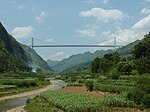G60 Shanghai–Kunming Expressway
Shanghai–Kunming Expressway | ||||
|---|---|---|---|---|
| 上海-昆明高速公路 | ||||
| Hukun Expressway 沪昆高速公路 | ||||
 | ||||
 A rural section of the Shanghai–Kunming Expressway in Xinhuang Dong Autonomous County, in the province of Hunan | ||||
| Route information | ||||
| Part of | ||||
| Length | 2,360 km[1] (1,470 mi) | |||
| Major junctions | ||||
| East end | S20 Outer Ring Expressway, S4 Hujin Expressway and Humin Elevated Road, Minhang District, Shanghai | |||
| West end | 2nd Ring Road, Kunming, Yunnan | |||
| Highway system | ||||
National Trunk Highway System
| ||||
The Shanghai–Kunming Expressway (Chinese: 上海—昆明高速公路), commonly referred to as the Hukun Expressway (Chinese: 沪昆高速公路) is an expressway that connects the cities of Shanghai, China, and Kunming, Yunnan. It is 2,360 km (1,470 mi) in length. The entire route forms part of Asian Highway 3.
Contents
1 Route[1]
1.1 Shanghai
1.2 Zhejiang
1.3 Jiangxi
1.4 Hunan
1.5 Guizhou
1.6 Yunnan
2 References
Route[1]
Shanghai
The Shanghai portion of the Shanghai–Kunming Expressway was originally designated A8 by the municipal government and was also known as the Shanghai–Hangzhou Expressway. In Shanghai, the Shanghai–Kunming Expressway is a concurrency for its entire length with G92 Hangzhou Bay Ring Expressway.
Zhejiang
The Zhejiang portion of the expressway runs from the Shanghai border to the Jiangxi border, passing through the cities of Hangzhou, Jinhua, and Quzhou.
Jiangxi
The Jiangxi portion of the expressway passes through the cities of Shangrao, Nanchang, Yichun, and Pingxiang.
Hunan
The Hunan section of the expressway passes through the cities of Zhuzhou, Shaoyang, and Huaihua.
Guizhou

Baling River Bridge in Guanling Buyei and Miao Autonomous County

Beipan River Hukun Expressway Bridge on the border of Guanling County and Anshun Prefecture
Hutiaohe Bridge on the border of Pan and Pu'an County
Zhuchanghe River Bridge in Pan County
Yunnan
In Yunnan Province, the expressway passes through the city of Qujing before terminating in Kunming.
References
^ ab G60 沪昆高速 (in Chinese)





